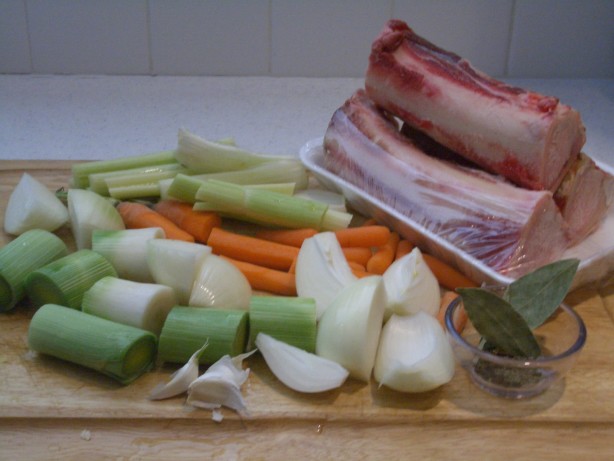
Basic to good French cooking, and by extension, to
all cooking, are good stocks and sauces. Good soups require
good stocks. Many sauces demand them. Vegetables gain in
appetizing flavor when they are cooked in stock. No self-
respecting cook should think of poaching a fish in other
than a fumet, a fish stock made with fish scraps, aromatics
and wine. However, you will use such a fumet or court
bouillon only when you poach a fish, so that it is not
necessary to keep fish stocks on hand, especially because
they are best made from the scraps and skeletons of the
fish to be poached. However, the usefulness of meat and
chicken stocks is so great that every cook should make her
own. They keep very well for considerable periods in a
deep freeze.
A big soup bone or several cuts of
shin bone and veal knuckle
4 – lbs. beef neck, chuck, rump
2 medium-size carrots
2 medium-brown onions
2 – 3 stalks of celery
2 bay leaves, some parsley
2 – 3 cloves of garlic
1/2 teaspoon tarragon
1/2 teaspoon thyme
1 dozen cloves (yep, you read it right – cloves)
Into a large pot put a big soup bone or several cuts
of beef shin bone, and a veal knuckle, which you will have
had cracked by your butcher when you buy it. Add four or
five pounds of beef neck, chuck, rump or other
moderately-priced cuts cut into pieces about two inch squares in
order to expose as much surface as possible to the water.
You may also add a suitable piece of beef brisket to the
pot for a dinner of boiled beef, being careful to remove it
when it is tender but before it becomes overcooked. Add
to the pot two medium-sized scraped carrots, two medium-
brown onions and two or three outside stalks of celery.
Also use the leaves from a bunch of celery to add a
pungent flavor. Make a bouquet garni by tying up in
cheesecloth two bay leaves, several sprigs of fresh parsley,
two large or three small cloves of garlic, a half teaspoon
each of tarragon and thyme, and about a dozen cloves. Add
to the pot.
Cover with cold water to a point two inches above
the top of the meat and put on a slow fire. When the water
starts to boil reduce the heat to a slow simmer; this means
that the surface of the liquid should be agitated only very
gently. For the first thirty to forty-five minutes of cooking,
carefully skim the coagulated protein and as much of the
fat as rises to the top.
Leave the lid of the kettle partly off and let the pot
simmer slowly for five hours. Add a little water occasion-
ally to replace that lost in boiling. Salt lightly during the
simmering.
Strain the stock into a bowl, let it cool sufficiently,
and then place it in the refrigerator overnight. Next day
remove the congealed fat as completely as possible. This
step is important. Use paper towels or blotting paper to get
up the last bit of fat; a consomme will not become properly
bright on clarification if it is fatty. In many cases, as
in making onion soup or minestrone, it is unnecessary to
clear the stock; to make an attractive aspic or consomme, it
is essential.
To Clear Stock
First, not only the stock but all of the bowls and
utensils to be used must be as free from fat as possible. In
a mixing bowl, beat up the whites of two eggs with one
cup of stock. (If the stock is rich enough to have become
jellied, heat it the minimum amount necessary to liquify
it.) Heat one or two quarts of the stock, as required, to
boiling and, while beating the egg white-stock mixture,
pour the boiling stock into the bowl. Put it back in the
heating pan and, while continuing to beat it, let it come to
a simmer. Reduce the heat so that the mixture barely
bubbles for fifteen or twenty minutes and then strain it
through several layers of clean cheesecloth.
